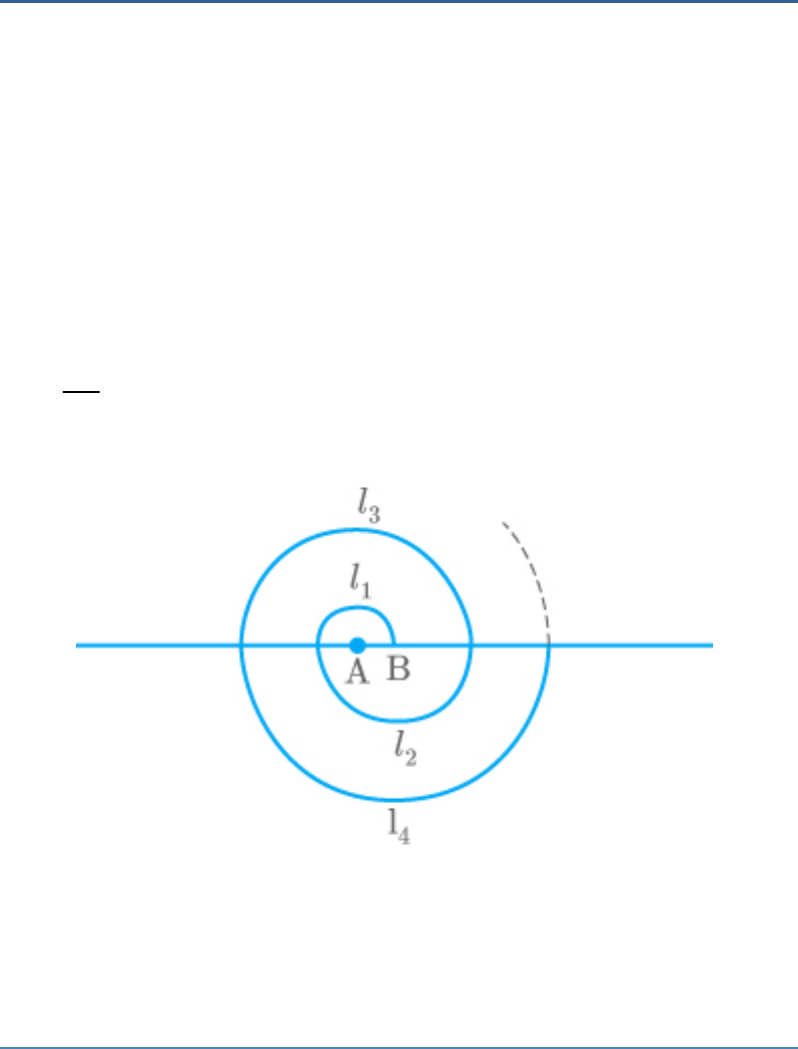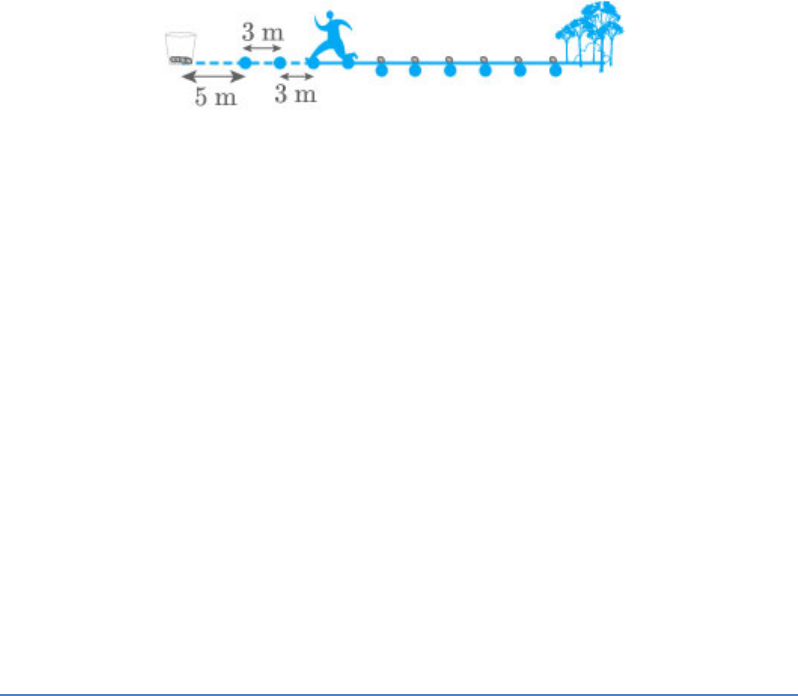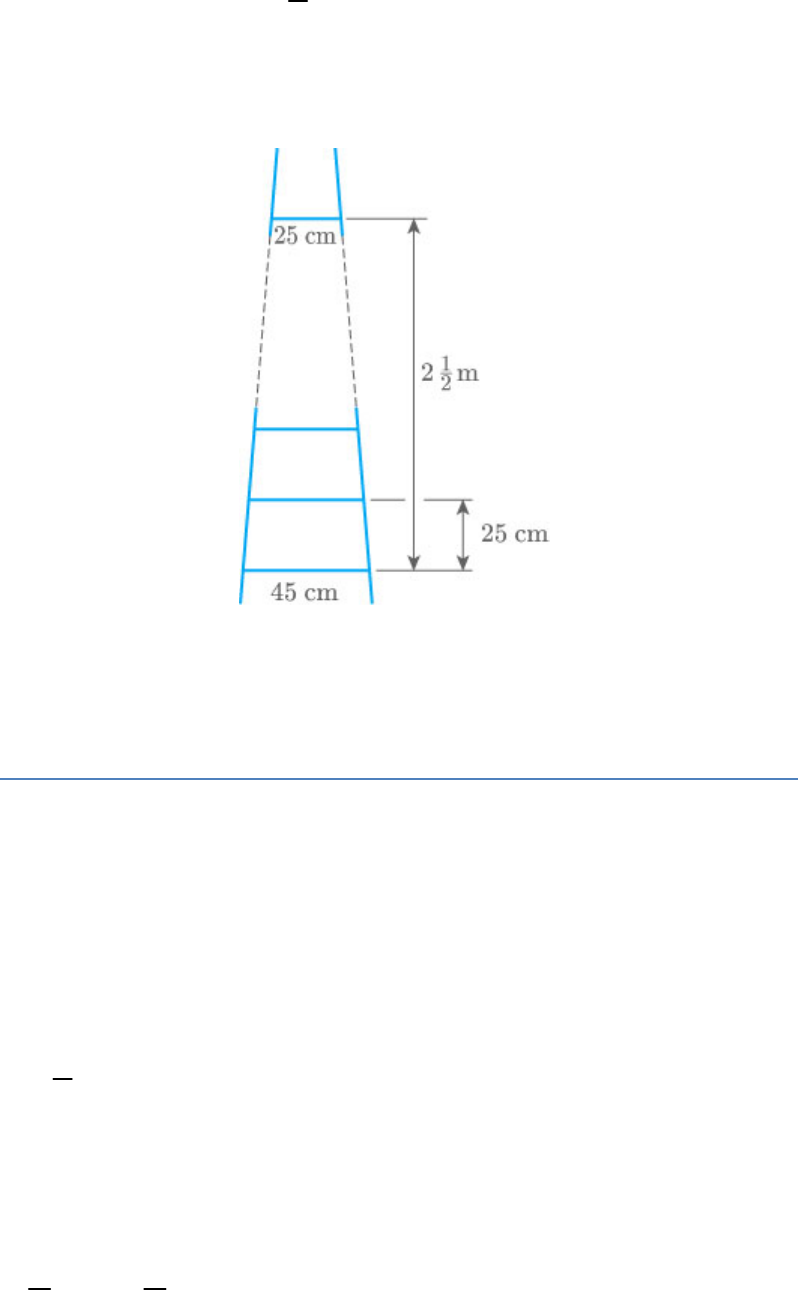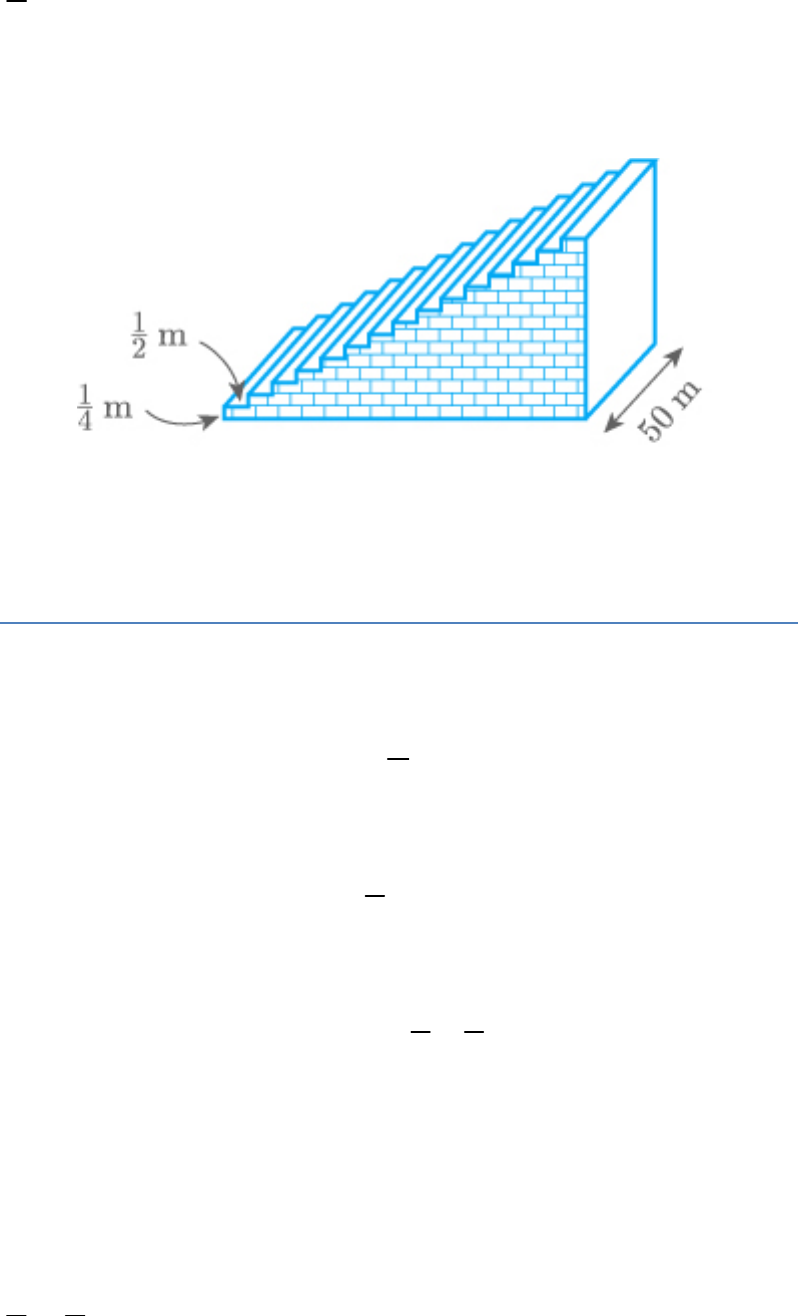
Lesson: Arithmetic Progressions
Exercise 5.1
Question: 1
In which of the following situations, does the list of
numbers involved make an arithmetic progression,
and why?
(i) The taxi fare after each km, when the fare is Rs.
15 for the first km and Rs. 8 for each additional
km.
(ii) The amount of air present in a cylinder when a
vacuum pump removes of the air remaining
1
4
in the cylinder at a time.
(iii) The cost of digging a well after every metre of
digging, when it costs Rs. 150 for the first metre
and rises by Rs. 50 for each subsequent metre.
(iv) The amount of money in the account every year,
when Rs. 10,000 is deposited at compound
interest at per annum.
8%

Solution
(i) For the first km, taxi fare
15 Rs
For the first two km, taxi fare
15 8
23
For the first three km, taxi fare
23 8
31
For the first four km, taxi fare
31 8
39
Thus, the sequence is .
15,
23,
31,
39,...
Common difference for each pair of terms is .
8
Clearly, the common difference is the same for
each pair of terms.
Hence, the list of numbers make an arithmetic
progression.
(ii) Let V litres be the volume of air in the cylinder.
According to the question,
In first stroke, the part of air remaining
4
v
v

4
4
v v
3
4
v
In second stroke, the remaining part of air
3 3 1
4 4 4
v v
3 1
1
4 4
v
3 3
4 4
v
2
3
4
v
In third stroke, the remaining part of air
2 2
3 3 1
4 4 4
v v
2
3 1
1
4 4
v
2
3 3
4 4
v

3
3
4
v
Thus, the sequence is
3
,
4
v
2
3
,
4
v
3
3
,...
4
v
Clearly, the common difference is not the same
for each pair of terms.
Hence, the list of numbers does not make an
arithmetic progression.
(iii) The cost involved in digging first metre
150
The cost involved in digging first two metres
150 50
200
The cost involved in digging first three metres
200 50
250
Thus, the sequence is .
150,
200,
250,...
Common difference for each pair of terms is 50.

Clearly, the common difference is same for each
pair of terms.
Hence, the list of numbers makes an arithmetic
progression.
(iv) The formula for compound interest is as follows:
Compound interest
1
100
n
r
p
Where, is the principal amount, is the rate
p
r
of interest, and is the number of years.
n
According to the question,
Interest in the first year
8
10000 1
100
Interest in the second year
2
8
10000 1
100
Interest in the third year
3
8
10000 1
100

Thus, the sequence is
8
1 ,
100
2
8
10000 1 ,
100
3
8
10000 1 ,...
100
Clearly, the common difference is not same for
each pair of terms.
Hence, the list of numbers does not make an
arithmetic progression.
Question: 2
Write first four terms of the AP, when the first term
a
and the common difference are given as follows:
d
(i)
10,a
10d
(ii)
2, a
0d
(iii)
4,a
3 d
(iv)
1, a
1
2
d
(v)
1.25, a
0.25 d
Solution
(i) Given:
10,a
10d
Let the sequence is .
1
,a
2
,a
3
,a
4
,...a
1
10 a a
2 1
a a d
10 10
20
3 2
a a d
20 10
30
4 3
a a d
30 10
40
Thus, the first four terms of the sequence are 10,
20, 30, 40.
(ii) Given:
2, a
0d
Let the sequence is .
1
,a
2
,a
3
,a
4
,...a
1
a a
2
2 1
a a d
2 0
2
3 2
a a d
2 0
2
4 3
a a d
2 0
2
Thus, the first four terms of the sequence are -2,
-2, -2, -2.
(iii) Given:
4,a
3 d
Let the sequence is .
1
,a
2
,a
3
,a
4
,...a
1
a a
4
2 1
a a d
4 3
1
3 2
a a d

1 3
2
4 3
a a d
2 3
5
Thus, the first four terms of the sequence are 4,
1, -2, -5.
(iv) Given:
1, a
1
2
d
Let the sequence is .
1
,a
2
,a
3
,a
4
,...a
1
a a
1
2 1
a a d
1
1
2
1
2
3 2
a a d

1 1
2 2
0
4 3
a a d
1
0
2
1
2
Thus, the first four terms of the sequence are
.
1,
1
,
2
0,
1
2
(v) Given:
1.25, a
0.25 d
Let the sequence is
1
,a
2
,a
3
,a
4
,...a
1
a a
1.25
2 1
a a d
1.25 0.25
1.50

3 2
a a d
1.50 0.25
1.75
4 3
a a d
1.75 0.25
2.00
Thus, the first four terms of the sequence are
.
1.25,
1.50,
1.75,
2.00
Question: 3
For the following APs, write the first term and the
common difference:
(i)
3,
1,
1,
3,...
(ii)
5,
1,
3,
7,...
(iii)
1
,
3
5
,
3
9
,
3
13
,...
3
(iv)
0.6,
1.7,
2.8,
3.9,...
Solution
(i) Given AP:
3,
1,
1,
3,...
Compare the given AP with
,a
,a d
2 ,a d
3 ,....a d
First term .
3a
Now, calculate the common difference.
d a d a
1 3
2
Hence, the first term is and the common
3
difference is .
2
(ii) Given AP:
5,
1,
3,
7,...
Compare the given AP with
,a
,a d
2 ,a d
3 ,....a d
First term .
5 a
Now, calculate the common difference.
d a d a
1 5
4
Hence, the first term is and the common
5
difference is .
4

(iii) Given AP:
1
,
3
5
,
3
9
,
3
13
,...
3
Compare the given AP with
,a
,a d
2 ,a d
3 ,....a d
First term .
1
3
a
Now, calculate the common difference.
d a d a
5 1
3 3
4
3
Hence, the first term is and the common
1
3
difference is .
4
3
(iv) Given AP:
0.6,
1.7,
2.8,
3.9,...
Compare the given AP with
,a
,a d
2 ,a d
3 ,...a d

First term .
0.6a
Now, calculate the common difference.
d a d a
1.7 0.6
1.1
Hence, the first term is and the common
0.6
difference is .
1.1
Question: 4
Which of the following are APs? If they form an AP,
find the common difference and write three more
d
terms.
(i)
2,
4,
8,
16,...
(ii)
2,
5
,
2
3,
7
,...
2
(iii)
1.2,
3.2,
5.2,
7.2,...
(iv)
10,
6,
2,
2,...
(v)
3,
3 2,
3 2 2,
3 3 2,...
(vi)
0.2,
0.22,
0.222,
0.2222,...
(vii)
0,
4,
8,
12,...
(viii)
1
,
2
1
,
2
1
,
2
1
,
2
,...
(ix)
1,
3,
9,
27,...
(x)
,a
2 ,a
3 ,a
4 ,...a

(xi)
,a
2
,a
3
,a
4
,...a
(xii)
2,
8,
18,
32,...
(xiii)
3,
6,
9,
12,...
(xiv)
2
1 ,
2
3 ,
2
5 ,
2
7 ,...
(xv)
2
1 ,
2
5 ,
2
7 ,
73,...
Solution
(i) Given:
2,
4,
8,
16,...
Compare the sequence with AP
1
,a
2
,a
3
,a
..., .
n
a
1
2,a
2
4,a
3
8,a
4
16a
Now, find the common difference.
2 1
4 2 a a
2
3 2
8 4 a a
4
4 3
16 8 a a
8
Clearly, the common difference is not same for
each pair of terms.
Hence, the given sequence does not form an AP.

(ii) Given:
2,
5
,
2
3,
7
,...
2
Compare the sequence with AP
1
,a
2
,a
3
,a
..., .
n
a
.
1
2,a
2
5
,
2
a
3
3,a
4
7
2
a
Now, find the common difference.
2 1
5
2
2
a a
5 4
2
1
2
3 2
5
3
2
a a
6 5
2
1
2
4 3
7
3
2
a a
7 6
2

1
2
Clearly, the common difference is same for each
pair of terms.
Thus, the given sequence forms an AP with the
common difference .
1
2
d
The next three terms will be:
5 4
a a d
7 1
2 2
8
2
4
6 5
a a d
1
4
2
8 1
2
9
2

7 6
a a d
9 1
2 2
10
2
5
Hence, the next three terms are and .
4,
9
2
5
(iii) Given:
1.2,
3.2,
5.2,
7.2,...
Compare the sequence with AP
1
,a
2
,a
3
,a
..., .
n
a
1
1.2, a
2
3.2, a
3
5.2, a
4
7.2 a
Now, find the common difference.
2 1
3.2 1.2 a a
2
3 2
5.2 3.2 a a
2
Clearly, the common difference is same for each
pair of terms.
Thus, the given sequence forms an AP with the
common difference .
2 d
The next three terms will be:
5 4
a a d
7.2 2
9.2
6 5
a a d
9.2 2
11.2
7 6
a a d
11.2 2
13.2
Hence, the next three terms are
9.2,
11.2,
and
13.2
(iv) Given:
10,
6,
2,
2,...
Compare the sequence with AP
1
,a
2
,a
3
,a
..., .
n
a
1
10, a
2
6, a
3
2, a
4
2a
Now, find the common difference.
2 1
6 10 a a
4
3 2
2 6 a a
4
4 3
2 2 a a
4
Clearly, the common difference is same for each
pair of terms.
Thus, the given sequence forms an AP with the
common difference .
4d
The next three terms will be:
5 4
a a d
5
2 4 a
5
6a
6 5
a a d

6
6 4 a
6
10a
7 6
a a d
7
10 4 a
7
14a
Hence, the next three terms are and .
6,
10,
14
(v) Given:
3,
3 2,
3 2 2,
3 3 2,...
Compare the sequence with AP
1
,a
2
,a
3
,.a
..., .
n
a
1
3,a
2
3 2, a
3
3 2 2, a
4
3 3 2 a
Now, find the common difference.
2 1
3 2 3 a a
2
3 2
3 2 2 3 2 a a
2
4 3
3 3 2 3 2 2 a a
2

Clearly, the common difference is same for each
pair of terms.
Thus, the given sequence forms an AP with the
common difference .
2d
The next three terms will be:
5 4
a a d
5
3 3 2 2 a
5
3 4 2 a
6 5
a a d
6
3 4 2 2 a
6
3 5 2 a
7 6
a a d
7
3 5 2 2 a
7
3 6 2 a
Hence, the next three terms are
3 4 2,
and .
3 5 2,
3 6 2
(vi) Given:
0.2,
0.22,
0.222,
0.2222,...
Compare the sequence with AP
1
,a
2
,a
3
,a
..., .
n
a
1
0.2,a
2
0.22,a
3
0.222,a
4
0.2222a
Now, find the common difference.
2 1
0.22 0.2 a a
0.02
3 2
0.222 0.22 a a
0.002
4 3
0.2222 0.222 a a
0.0002
Clearly, the common difference is not same for
each pair of terms.
Hence, the given sequence does not form an AP.
(vii) Given:
0,
4,
8,
12,...
Compare the sequence with AP
1
,a
2
,a
3
,a
..., .
n
a
1
0,a
2
4, a
3
8, a
4
12 a
Now, find the common difference.
2 1
4 0 a a
4
3 2
8 4 a a
4
Clearly, the common difference is same for each
pair of terms.
Thus, the given sequence forms an AP with the
common difference .
4 d
The next three terms will be:
5 4
a a d
5
12 4 a
5
16 a
6 5
a a d
6
16 4 a
6
20 a
7 6
a a d
7
20 4 a

7
24 a
Hence, the next three terms are and
16,
20,
.
24
(viii) Given:
1
,
2
1
,
2
1
,
2
1
,...
2
Compare the sequence with AP
1
,a
2
,a
3
,a
..., .
n
a
1
1
,
2
a
2
1
,
2
a
3
1
,
2
a
4
1
2
a
Now, find the common difference.
2 1
1 1
2 2
a a
0
3 2
1 1
2 2
a a
0
4 3
1 1
2 2
a a
0

Clearly, the common difference is same for each
pair of terms.
Thus, the given sequence forms an AP with the
common difference .
0d
The next three terms will be:
5 4
a a d
5
1
0
2
a
5
1
2
a
6 5
a a d
6
1
0
2
a
6
1
2
a
7 6
a a d
7
1
0
2
a
7
1
2
a

Hence, the next three terms are and
1
,
2
1
,
2
.
1
2
(ix) Given:
1,
3,
9,
27,...
Compare the sequence with AP
1
,a
2
,a
3
,a
..... .
n
a
1
1,a
2
3,a
3
9,a
4
27a
Now, find the common difference.
2 1
3 1 a a
2
3 2
9 3 a a
6
4 3
27 9 a a
18
Clearly, the common difference is not same for
each pair of terms.
Hence, the given sequence does not form an AP.
(x) Given:
,a
2 ,a
3 ,a
4 ,...a
Compare the sequence with AP
1
,a
2
,a
3
,a
..., .
n
a
1
,a a
2
2 ,a a
3
3 ,a a
4
4a a
Now, find the common difference.
2 1
2 a a a a
a
3 2
3 2 a a a a
a
4 3
4 3 a a a a
a
Clearly, the common difference is same for each
pair of terms.
Thus, the given sequence forms an AP with the
common difference .
d a
The next three terms will be:
5 4
a a d
5
4 a a a
5
5a a
6 5
a a d
6
5 a a a
6
6a a
7 6
a a d
7
6 a a a
7
7a a
Hence, the next three terms are and .
5 ,a
6 ,a
7a
(xi) Given:
,a
2
,a
3
,a
4
,...a
Compare the sequence with AP
1
,a
2
,a
3
,a
..., .
n
a
1
,a a
2
2
,a a
3
3
,a a
4
4
a a
Now, find the common difference.
2
2 1
a a a a
1 a a
3 2
3 2
a a a a
2
1 a a
4 3
4 3
a a a a

3
1 a a
Clearly, the common difference is not same for
each pair of terms.
Hence, the given sequence does not form an AP.
(xii) Given:
2,
8,
18,
32,...
Compare the sequence with AP .
1
,a
2
,a
3
,.a
...,
n
a
1
2,a
2
8,a
3
18,a
4
32a
Now, find the common difference.
2 1
8 2 a a
2 2 2
2
3 2
18 8 a a
3 2 2 2
2
4 3
32 18 a a
4 2 3 2

2
Clearly, the common difference is the same for
each pair of terms.
Thus, the given sequence forms an AP with the
common difference .
2d
The next three terms will be:
5 4
a a d
5
32 2 a
5
4 2 2 a
5
5 2a
6 5
a a d
6
5 2 2 a
6
6 2a
7 6
a a d
7
6 2 2 a
7
7 2a

Hence, the next three terms are and
5 2,
6 2
.
7 2
(xiii) Given:
3,
6,
9,
12,...
Compare the sequence with AP
1
,a
2
,a
3
,a
..., .
n
a
1
3,a
2
6,a
3
9,a
4
12a
Now, find the common difference.
2 1
6 3 a a
3 2 3
3 2 1
3 2
9 6 a a
3 3 2
3 3 2

4 3
12 9 a a
2 3 3
3 2 3
Clearly, the common difference is not same for
each pair of terms.
Hence, the given sequence does not form an AP.
(xiv) Given:
2
1 ,
2
3 ,
2
5 ,
2
7 ,...
Compare the sequence with AP
1
,a
2
,a
3
,a
..., .
n
a
2
1
1 ,a
2
2
3 ,a
2
3
5 ,a
2
4
7a
Now, find the common difference.
2 2
2 1
3 1 a a
9 1
8
2 2
3 2
5 3 a a
25 9
16
2 2
4 3
7 5 a a
49 25
24
Clearly, the common difference is not same for
each pair of terms.
Hence, the given sequence does not form an AP.
(xv) Given:
2
1 ,
2
5 ,
2
7 ,
73,...
Compare the sequence with AP .
1
,a
2
,a
3
,a
...,
n
a
2
1
1 ,a
2
2
5 ,a
2
3
7 ,a
4
73a
Now, find the common difference.
2 2
2 1
5 1 a a
25 1
24
2 2
3 2
7 5 a a
49 25
24
2
4 3
73 7 a a
73 49
24
Clearly, the common difference is the same for
each pair of terms.
Thus, the given sequence forms an AP with the
common difference .
24d
The next three terms will be:
5 4
a a d
5
73 24 a
5
97a
6 5
a a d
6
97 24 a
6
121a
7 6
a a d
7
121 24 a
7
145a
Hence, the next three terms are and .
97,
121,
145

Exercise 5.2(20)
Question: 1
Fill in the blanks in the following table, given that is
a
the first term, is the common difference and is
d
n
a
the term of the AP:
th
n
a
d
n
n
a
(i)
7
3
8
…
(ii)
18
…
10
0
(iii)
…
3
18
5
(iv)
18.9
2.5
…
3.6
(v)
3.5
0
105
…
Solution
(i) Given:
7,a
3,d
8n
By the formula of the term.
th
n
1
n
a a n d
Put the values of and .
,a d
n

7 8 1 3
n
a
7 7 3
7 21
28
Hence, the term of the AP is .
th
n
28
(ii) Given:
18, a
0,
n
a
10n
By the formula of the term.
th
n
1
n
a a n d
Put the values of and .
,
n
a a
n
0 18 10 1 d
0 18 9 d
18
9
d
2d
Hence, the common difference is .
2
(iii) Given:
3, d
5,
n
a
18n
By the formula of the term.
th
n
1
n
a a n d
Put the values of and .
,d
n
a
n
5 18 1 3 a
5 17 3 a
5 51 a
46a
Hence, the first term of the AP is .
46
(iv) Given:
18.9, a
2.5,d
3.6
n
a
By the formula of the term.
th
n
1
n
a a n d
Put the values of and .
,a d
n
a
3.6 18.9 1 2.5 n
3.6 18.9 1 2.5 n

22.5
1
2.5
n
1 9 n
9 1 n
10n
Hence, .
10n
(v) Given:
3.5,a
0,d
105n
By the formula of the term.
th
n
1
n
a a n d
Put the values of and
,a
d
n
3.5 105 1 0
n
a
3.5 0
n
a
3.5
n
a
Hence, the term of the AP is .
th
n
3.5
Question: 2

Select the correct option in the following and justify
your choice:
(i) term of the AP: is
th
30
10,
7,
4,...,
(A)
97
(B)
77
(C)
77
(D)
87
(ii) term of the AP: is
th
11
3,
1
,
2
2,...,
(A)
28
(B)
22
(C)
38
(D)
1
48
2
Solution
(i) Given AP:
10,
7,
4,...
Compare the given AP with the AP
1
,a
2
,a
3
,a
.
.....
n
a
1
10,a
2
7,a
3
4a
First term
1
a a
10
Common difference
2 1
d a a
7 10

3
To find the 30
th
term, use the formula of the
th
n
term.
1
n
a a n d
30
30 1 a a d
10 30 1 3
10 29 3
10 87
77
Hence, the term of the AP is .
th
30
77
(ii) Given AP:
3,
1
,
2
2,...
Compare the given AP with the AP
1
,a
2
,a
3
,.a
.
....
n
a
1
3 a
2
1
2
a
3
2a

First term
1
a a
3
Common difference
2 1
d a a
1
3
2
1 6
2
5
2
To find the term, use the formula of the
th
11
th
n
term.
1
n
a a n d
11
11 1 a a d
5
3 11 1
2
10 5
3
2
3 5 5

22
Hence, the term of the AP is .
th
11
22
Question: 3
In the following APs, find the missing terms in the
boxes:
(i)
2,
,
26
(ii)
,
13 ,
3
(iii)
5,
,
,
1
9
2
(iv)
4,
,
,
,
,
6
(v)
,
38 ,
,
,
22
Solution
(i) Given:
2,
,
26
and
1
a a
2
3
26a
By the formula of the term,
th
n
1
n
a a n d
3
3 1 a a d
Put the values of and .
a
3
a
26 2 3 1 d
26 2 2 d

2 26 2 d
24
2
d
The second term .
2
2 1 a a d
Put the values of and .
a
d
2
2 2 1 12 a
2
2 1 12 a
2
14a
Thus, the missing terms is .
14
(ii) Given:
,
13 ,
3
From the given AP,
and
2
13,a
4
3a
By the formula of the term,
th
n
1
n
a a n d
2
2 1 a a d
.............................................(1)
13 a d

4
4 1 a a d
...............................................(2)
3 3 a d
Subtract equation (1) from (2).
3 13 3 a d a d
10 2 d
10
2
d
5 d
From equation (1).
13 5 a
13 5 a
18a
Thus, the first term is .
18
3
3 1 a a d
Put the values of and .
a
d
3
3 1 a a d
18 2 5

18 10
8
Thus, the third term is .
8
Hence, the missing terms are and .
18
8
(iii) Given:
5,
,
,
1
9
2
From the given AP,
,
1
a a
5
4
1
9
2
a
By the formula of the term,
th
n
1
n
a a n d
4
4 1 a a d
1
9 5 4 1
2
d
19
5 3
2
d
19
3 5
2
d

19 10
3
2
d
9
3
2
d
9
2 3
d
3
2
d
The second term, .
2
a a d
Put the values of
and .
a
d
2
3
5
2
a
10 3
2
13
2
The third term,
3 2
a a d
Put the values of and .
2
a
d
3
13 3
2 2
a

3
16
2
a
3
8a
Thus, the missing terms are and .
13
2
8
(iv) Given:
4,
,
,
,
,
6
From the given AP,
,
1
a a
4
6
6a
By the formula of the term,
th
n
1
n
a a n d
6
6 1 a a d
Put the values of and .
6
a
a
6 4 6 1 d
6 4 5 d
5 6 4 d
5 10d

10
5
d
2d
The second term, .
2
a a d
Put the values of and .
a
d
2
4 2 a
2
2 a
The third term, .
3 2
a a d
Put the values of and .
2
a
d
3
2 2 a
3
0a
The fourth term, .
4 3
a a d
Put the values of and .
3
a
d
4
0 2 a
4
2a
The fifth term, .
5 4
a a d
Put the values of and .
4
a
d

5
2 2 a
5
4a
Thus, the missing terms are .
2,
0,
2,
4
(v) Given:
,
38 ,
,
,
22
From the given AP,
and
2
38a
6
22 a
By the formula of the term,
th
n
1
n
a a n d
2
2 1 a a d
… (1)
38 a d
6
6 1 a a d
… (2)
22 5 a d
Subtract equation (1) from (2).
22 38 5 a d a d
60 4 d
60
4
d
15 d
From equation (1).
38 15 a
38 15 a
53a
Thus, the first term is .
53
The third term,
3 2
a a d
Put the values of and .
2
a
d
3
38 15 a
3
23a
The fourth term,
4 3
a a d
Put the values of and .
3
a
d
4
23 15 a
4
8a
The fifth term,
5 4
a a d
Put the values of and .
4
a
d
5
8 15 a

5
7 a
Thus, the missing terms are .
53,
23,
8,
7
Question: 4
Which term of the AP: is ?
3,
8,
13,
18,...,
78
Solution
The given AP is
3,
8,
13,
18,...,
Compare the given AP with the AP .
1
,a
2
,a
3
,.a
....
n
a
.
1
3,a
2
8,a
3
13a
The first term,
1
a a
3
Common difference
2 1
d a a
8 3
5
Formula for the term
th
n
1
n
a a n d
The term is
th
n
78
So,
78
n
a

1 78 a n d
3 1 5 78 n
1 5 78 3 n
5 5 75 n
5 75 5 n
80
5
n
16n
Hence, 78 is the 16
th
term of the AP
3,
8,
13,
18,...
Question: 5
Find the number of terms in each of the following
APs:
(i)
7,
13,
19,
...,205
(ii)
18,
1
15 ,
2
13,
..., 47
Solution
(i) Given AP:
7,
13,
19,.
..,205
Compare the given AP with the AP
1
,a
2
,a
3
,a
.
.....
n
a

1
7,a
2
13,a
3
19,a
205
n
a
The first term
1
a a
7
Common difference
2 1
d a a
13 7
6
By the formula of the term.
th
n
1
n
a a n d
205 7 1 6 n
205 7 1 6 n
198 1 6 n
198
1
6
n
1 33 n
33 1 n
34n
Thus, the given AP has terms.
34

(ii) Given AP:
18,
1
15 ,
2
13,...,
47
Compare the given AP with the AP
1
,a
2
,a
3
,a
.
.....
n
a
1
18,a
2
1
15 ,
2
a
3
13,a
47
n
a
The first term
1
a a
18
Common difference
2 1
d a a
1
15 18
2
31
18
2
31 36
2
5
2
By the formula of the term.
th
n
1
n
a a n d

5
47 18 1
2
n
5
47 18 1
2
n
5 1 2 65 n
2 65
1
5
n
1 26 n
26 1 n
27n
Thus, the given AP has terms.
27
Question: 6
Check whether or not is a term of the AP
150
11,
8,
5,
2,...
Solution
The given AP is .
11,
8,
5,
2,...
Compare the given AP with the AP .
1
,a
2
,a
3
,a
...,
n
a
1
11,a
2
8,a
3
5,a
4
2a
The first term,
1
a a

11
Common difference
2 1
d a a
8 11
3
The term of the given AP is
th
n
150
By the formula of the term.
th
n
1
n
a a n d
150 11 1 3 n
150 11 3 1 n
3 3 161 n
3 161 3 n
3 164n
164
3
n
is not an integer.
164
3
n
Thus, is not a term of the given AP.
150

Question: 7
Find the term of an AP whose term is 38 and
st
31
th
11
the term is 73.
th
16
Solution
By the formula for the term of an AP,
th
n
1
n
a a n d
… (1)
11
11 1 a a d
… (2)
16
16 1 a a d
According to the question,
and
11
38a
16
73a
Put these values in equation (1) and (2).
11 1 38 a d
… (3)
10 38 a d
16 1 73 a d
… (4)
15 73 a d
Subtract equation (3) from (4).
15 10 73 38 a d a d
5 35d

7d
Put the value of in equation (3).
d
10 7 38 a
38 70 a
32 a
The 31
st
term of the AP is
31
31 1 a a d
Put the value of and
a
d
31
32 31 1 7 a
31
32 31 1 7 a
32 210
178
Thus, the 31
st
term of the given AP is .
178
Question: 8
An AP consists of 50 terms of which the term is 12
rd
3
and the last term is 106. Find the term.
th
29
Solution
By the formula for the term of an AP,
th
n

1
n
a a n d
… (1)
3
3 1 a a d
… (2)
50
50 1 a a d
According to the question,
3 1 12 a d
… (3)
2 12 a d
50 1 106 a d
… (4)
49 106 a d
Subtract equation (3) from (4).
49 2 106 12 a d a d
47 94d
94
47
d
2d
Put the value of in equation (3).
d
2 12 a d
2 2 12 a
12 4 a

8a
The term of the AP is .
th
29
29
29 1 a a d
Put the value of and .
a
d
29
8 29 1 2 a
8 28 2
8 56
64
Thus, the term of the AP is .
th
29
64
Question: 9
If the 3
rd
and the 9
th
terms of an AP are 4 and
8
respectively, which term of this AP is zero?
Solution
By the formula for the term of an AP,
th
n
1
n
a a n d
… (1)
3
3 1 a a d
… (2)
9
9 1 a a d

According to the question,
3 1 4 a d
… (3)
2 4 a d
9 1 8 a d
… (4)
8 8 a d
Subtract equation (3) from (4).
8 2 8 4 a d a d
6 12 d
12
6
d
2 d
Put the value of in equation (3).
d
2 2 4 a
4 4 a
4 4 a
8a
Let the AP have its term as zero.
th
n
1 0 a n d

Put the values of and .
a
d
8 1 2 0 n
8 2 2 0 n
2 8 2 n
2 10n
10
2
n
5n
Thus, the term of the given AP is zero.
th
5
Question: 10
The 17
th
term of an AP exceeds its 10
th
term by 7. Find
the common difference.
Solution
By the formula for the term of an AP,
th
n
1
n
a a n d
................(1)
17
17 1 a a d
.................(2)
10
10 1 a a d
According to the question,

17 10
7 a a
From equations (1) and (2)
17 1 10 1 7 a d a d
16 9 7 d d
7 7d
7
7
d
1d
Thus, the common difference of the AP is .
1
Question: 11
Which term of the AP: will be 132 more
3,
15,
27,
39,...
than its 54
th
term?
Solution
The given AP is
3,
15,
27,
39,...
Compare the given AP with the AP
1
,a
2
,a
3
,a
...,
n
a
1
3,a
2
15,a
3
27,a
4
39a
The first term,
1
a a
3
Common difference
2 1
d a a
15 3
12
To find the term, use the formula of the
th
54
th
n
term.
1
n
a a n d
54
54 1 a a d
Put the values of and .
a
d
54
3 54 1 12 a
3 53 12
3 636
639
Let term be the required term which is 132 more
th
n
than the term
th
54
54
132
n
a a
639 132
n
a
771
n
a

By the formula of the term.
th
n
1
n
a a n d
Put the value of and
,
n
a a
d
771 3 1 12 n
771 3 1 12 n
768
1
12
n
1 64 n
64 1 n
65n
Thus, the term of the given AP will be 132 more
th
65
than its term.
th
54
Question: 12
Two APs have the same common difference. The
difference between their 100
th
terms is 100, what is
the difference between their 1000
th
terms?
Solution
Let and be the first terms of the two APs, and
1
a
2
a
d
is their common difference.
By the formula for the term of an AP,
th
n
1
n
a a n d
In the case of the first AP
100 1
100 1 a a d
1000 1
1000 1 a a d
For the case of the second AP
100 2
100 1 a a d
1000 2
1000 1 a a d
According to the question,
The term of first AP the term of second AP
th
100
th
100
100
1 2
100 1 100 1 100 a d a d
… (1)
1 2
100 a a
Now, calculate the difference between the 1000
th
term of the two APs.

1 2 1 2
1000 1 1000 1 a d a d a a
From equation (1),
1 2
100 a a
Thus, the difference between the 1000
th
term of the
two APs is .
100
Question: 13
How many three-digit numbers are divisible by 7?
Solution
The first three-digit number which can be divided by
7 is 105.
The second number
105 7
112
All other numbers can be found by adding 7 to the
subsequent numbers.
Thus, the sequence of three-digit numbers that can
be divided by 7 can be written as:
105,
112,
119,...
This sequence forms an AP as the common difference
is same for all pair of terms.
7d
Compare the given AP with the AP
1
,a
2
,a
3
,a
...,
n
a
1
105,a
2
112,a
3
119a
the first term,
1
105 a a
When the biggest three-digit number, 999 is divided
by 7, it gives remainder 5.
Thus, is the biggest three-digit number
999 5 994
that can be divided by 7.
Thus is the last term of the AP.
994
The resultant AP is .
105,
112,
119,
...,994
Let the term of the AP is .
th
n
994
By the formula for the term of an AP,
th
n
1
n
a a n d
994 105 1 7 n
994 105 1 7 n
889 1 7 n

889
1
7
n
1 127 n
127 1 n
128n
Hence, 128 three-digit numbers can be divided by 7.
Question: 14
How many multiples of 4 lie between 10 and 250?
Solution
The first multiple of 4 which is greater than 10 is .
12
The second multiple
12 4
16
All other multiples of 4 can be found by adding 4 to
the subsequent numbers.
Thus, the sequence of the multiples of 4 greater than
10 can be written as:
12,
16,
20,
24,...
This sequence forms an AP as the common difference
, which is same for all pair of terms.
4d
Compare the given AP with the AP
1
,a
2
,a
3
,a
...,
n
a
1
12,a
2
16,a
3
20a
First term
1
a a
12
When, 250 is divided by 4, it gives remainder 2.
Thus, is the biggest multiple of 4 less
250 2 248
than 250.
Thus is the last term of the AP.
248
The resultant AP is
12,
16,
20,
24,...,
248
Let the term of the AP be
th
n
248
By the formula for the term of an AP,
th
n
1
n
a a n d
248 12 1 4 n
248 12 1 4 n
1 4 236 n

236
1
4
n
1 59 n
59 1 n
60n
Thus, 60 multiples of 4 exist between and .
10
250
Question: 15
For what value of are the terms of two Aps:
n
th
n
63,
and equal?
65,
67,...
3,
10,
17,...
Solution
For the first AP
63,65,67,...
1
63,a
2
65,a
3
67a
The first term,
1
a a
63
Common difference
2 1
d a a
65 63 2
By the formula of the term.
th
n
1
n
a a n d
.........(1)
63 1 2
n
a n
For the second AP
3,
10,
17,...
1
3,a
2
10,a
3
17a
First term
1
a a
3
Common difference
2 1
d a a
10 3
7
By the formula of the term.
th
n
1
n
a a n d
.........(2)
3 1 7
n
a n
According to the question,
The term of the first AP The term of the
th
n
th
n
second AP.
From equation (1) and (2).
63 1 2 3 1 7 n n
63 3 1 7 1 2 n n

60 7 7 2 2 n n
60 2 7 5 n
5 65n
65
5
n
13n
Thus, for , the terms of the two given APs
13n
th
n
are equal.
Question: 16
Determine the AP whose third term is 16 and the 7
th
term exceeds the 5
th
term by 12.
Solution
By the formula for the term of an AP,
th
n
1
n
a a n d
3
3 1 a a d
7
7 1 a a d
5
5 1 a a d
According to the question,

3 1 16 a d
...........(1)
2 16 a d
And
7 5
12 a a
Thus,
7 1 5 1 12 a d a d
6 4 12 d d
2 12d
12
2
d
6d
Put the value of in equation (1).
d
2 6 16 a
12 16 a
16 12 a
4a
Now,
4 6 a d
10
2 4 2 6 a d

4 12
16
The AP will be
,a
,a d
2 ,a d
3 ,...a d
Thus, the required AP is
4,
10,
16,...
Question: 17
Find the 20
th
term from the last term of the AP
3,
8,
13,
.
...,253
Solution
The given AP is
3,
8,
13,
...,253
Since we need to find the 20
th
term from the last
term, we would first write the series in reverse order.
The AP, in reverse order, would be:
253,.......13,8,3
For the reverse-ordered AP:
First term = 253
Common difference,
3 8 d
5
As per the formula for the n
th
term of an AP,

1
n
a a n d
Therefore,
20
253 20 1 5 a
253 19 5
253 95
158
Thus, the 20
th
term from the last term of the given AP
is 158.
Question: 18
The sum of the fourth and eighth terms of an AP is 24
and the sum of the sixth and tenth terms is 44. Find
the first three terms of the AP.
Solution
By the formula for the term of an AP,
th
n
1
n
a a n d
4
4 1 ......(1)a a d
8
8 1 ......(2)a a d
6
6 1 ......(3)a a d
10
10 1 ......(4)a a d
According to the question,
and
4 8
24a a
6 10
44a a
From equations (1) and (2).
4 1 8 1 24a d a d
2 3 7 24a d d
2 10 24a d
5 12 ......(5)a d
From equations (3) and (4).
6 1 10 1 44a d a d
2 5 9 44a d d
2 5 9 44a d d
7 22 ......(6)a d
Subtract equation (5) from (6).

7 5 22 12a d a d
2 10d
10
2
d
5d
From equation (5).
5 5 12a
25 12a
12 25a
13a
The second term,
2
a a d
13 5
8
The third term,
3 2
a a d
8 5
3
Thus, and are the first three terms of the
13,
8
3
AP.

Question: 19
Subba Rao started work in 1995 at an annual salary of
Rs 5,000 and received an increment of Rs 200 each
year. In which year did his income reach Rs 7,000?
Solution
Since Subba Rao received an increment of Rs 200
each year, his salary in each year after 1995 can be
written as:
5000,
5000 200 ,
5000 200 200 ,...
5000,
5200,
5400,...,
This sequence forms an AP since the common
difference,
, is same for each pair of terms.
200d
In this AP,
1
5000,a
2
5200,a
3
5400a
The first term,
1
5000a a
By the formula for the term of an AP,
th
n
1 ......(1)
n
a a n d
Let the salary of Subba Rao reach in the
7000
th
n
year.

Therefore, .
7000
n
a
Put the values of , and in equation (1).
n
a
a
d
7000 5000 1 200n
7000 5000 1 200n
1 200 2000n
2000
1
200
n
1 10n
10 1n
11n
Hence, the salary of Subba Rao will reach in the
7000
year.
Question: 20
Ramkali saved Rs 5 in the first week of a year and
then increased her weekly savings by Rs 1.75. If in the
week, her weekly savings becomes Rs 20.75, find her
weekly savings.
Solution
Since Ramkali started with saving Rs 5 with an
increment of Rs 1.75 each week, her savings in each
week can be written as:
5,
5 1.75 ,
5 1.75 1.75 ,...,
5,
6.75,
8.5,...,
This sequence forms an AP since the common
difference is same for each pair of terms.
1.75d
In this AP,
1
5,a
2
6.75,a
3
8.5a
The first term
1
5a a
By the formula for the term of an AP,
th
n
1 ......(1)
n
a a n d
According to the question,
In the week, weekly savings of Ramkali become Rs
th
n
20.75.
Thus, .
20.75
n
a
Put the values of and in equation (1).
,
n
a
a
d
20.75 5 1 1.75n

20.75 5 1 1.75n
1 1.75 15.75n
15.75
1
1.75
n
1 9n
9 1n
10n
Hence, .
10n
Exercise 5.3 (20)
Question: 1
Find the sum of the following APs:
(i) to 10 terms.
2,
7,
12,...
(ii) to 12 terms.
37,
33,
29,...
(iii) to 100 terms.
0.6,
1.7,
2.8,...
(iv) to 11 terms.
1
,
15
1
,
12
1
,...
10
Solution
(i) Given: to 10 terms.

For the given AP,
1
2,a a
2
7,a
3
12a
Common difference
2 1
7 2 5d a a
The sum of the first terms is
n
.
2 1
2
n
n
S a n d
Here, .
10n
10
10
2 2 10 1 5
2
S
5 4 9 5
5 4 45
5 49
245
Thus, the sum of the first 10 terms is 245.
(ii) Given AP: to 12 terms.
37,
33,
29,...
For the given AP,
1
37,a a
2
33,a
3
29a
Common difference
2 1
33 37 4d a a

The sum of the first terms is
n
.
2 1
2
n
n
S a n d
Here, .
12n
12
12
2 37 12 1 4
2
S
6 74 11 4
6 74 44
6 30
180
Thus, the sum of the first 12 terms is
180
(iii) Given AP: to 100 terms.
0.6,
1.7,
2.8,...,
For the given AP,
1
0.6,a a
2
1.7,a
3
2.8a
Common difference
2 1
1.7 0.6 1.1d a a
The sum of the first terms is
n
.
2 1
2
n
n
S a n d

Here .
100n
100
100
2 0.6 100 1 1.1
2
S
50 1.2 99 1.1
50 1.2 108.9
50 110.1
5505
Thus, the sum of the first 100 terms is 5505.
(iv) Given AP: to 11 terms.
1
,
15
1
,
12
1
,...,
10
For the given AP,
1
1
,
15
a a
2
1
,
12
a
3
1
10
a
Common difference,
2 1
d a a
1 1
12 15
5 4
60

1
60
The sum of the first terms is
n
.
2 1
2
n
n
S a n d
Here, .
11n
11
11 1 1
2 11 1
2 15 60
S
11 2 10
2 15 60
11 4 2 1 10
2 60
11 8 10
2 60
11 18
2 60
33
20
Thus, the sum of the first 11 terms is
33
20
Question: 2

Find the sums given below:
(i)
1
7 10 14 ... 84
2
(ii)
34 32 30 ... 10
(iii)
5 8 11 ... 230
Solution
(i) Given:
1
7 10 14 ... 84
2
For the given AP,
1
7,a a
2
1
10 ,
2
a
3
14,a
84l
Common difference
2 1
1 21 21 14 7
10 7 7
2 2 2 2
d a a
By the formula for the term of an AP,
th
n
1l a n d
7
84 7 1
2
n

7
84 7 1
2
n
7
77 1
2
n
2
1 77
7
n
1 11 2n
1 22n
22 1n
23n
The sum of the first terms is .
n
2
n
n
S a l
23
23
7 84
2
S
23
91
2
2093
2
Hence, the required sum is .
1
1046
2

(ii) Given:
34 32 30 ... 10
For the given AP,
1
a a
34
2
32a
3
30a
10l
Common difference
2 1
32 34 2d a a
By the formula for the term of an AP,
th
n
1l a n d
10 34 1 2n
10 34 1 2n
24 1 2n
24
1
2
n
1 12n
12 1n
13n

The sum of the first terms is .
n
2
n
n
S a l
13
13
34 10
2
S
13
44
2
13 22
286
Hence, the required sum is .
286
(iii) Given:
5 8 11 ... 230
For the given AP,
1
5,a a
2
8,a
3
11,a
230l
Common difference
2 1
8 5 3d a a
By the formula for the term of an AP,
th
n
1l a n d

230 5 1 3n
230 5 1 3n
225 1 3n
225
1
3
n
1 75n
75 1n
76n
The sum of the first terms is .
n
2
n
n
S a l
76
76
5 230
2
S
38 235
8930
Hence, the required sum is
8930
Question: 3
In an AP:
(i) given , find and .
5,a
3,d
50
n
a
n
n
S

(ii) given , find and .
7,a
13
35a
d
13
S
(iii) given , find and .
12
37,a
3d
a
12
S
(iv) given , find and .
3
15,a
10
125S
d
10
a
(v) given , find and .
5,d
9
75S
a
9
a
(vi) given , find and .
2,a
8,d
90
n
S
n
n
a
(vii) given , find and .
8,a
62,
n
a
210
n
S
n
d
(viii) given , find and .
4,
n
a
2,d
14
n
S
n
a
(ix) given , find .
3,a
8,n
192S
d
(x) given ,and there are total 9 terms.
28,l
144S
Find .
a
Solution
(i) Given:
5,a
3,d
50
n
a
By the formula for the term of an AP,
th
n
1
n
a a n d
50 5 1 3n
1 3 50 5n
1 3 45n
45
1
3
n

1 15n
15 1n
16n
The sum of the first
n
terms is
2
n n
n
S a a
.
16
16
5 50
2
S
8 55
440
Hence,
16n
and
440
n
S
.
(ii) Given:
7,a
13
35a
.
By the formula for the
th
n
term of an AP,
1
n
a a n d
13
13 1a a d
35 7 12d
35 7 12d
28
12
d

7
3
d
The sum of the first
n
terms is
2
n n
n
S a a
.
13 13
13
2
S a a
13 7 35
2
13 42
2
13 21
273
Hence,
7
3
d
and
13
273S
.
(iii) Given:
12
37,a
3d
By the formula for the
th
n
term of an AP,
1
n
a a n d

12
12 1
37 11 3
37 33
4
a a d
a
a
a
The sum of the first
n
terms is
2
n n
n
S a a
.
12 12
12
2
S a a
6 4 37
6 41
246
Hence,
4a
and
12
246S
.
(iv) Given:
3
15,a
10
125S
By the formula for the
th
n
term of an AP,
1
n
a a n d
3
3 1a a d
15 2 ......(1)a d

The sum of the first
n
terms is
2 1
2
n
n
S a n d
.
10
10
2 10 1
2
S a d
125 5 2 9a d
125
2 9
5
a d
2 9 25 ......(2)a d
Multiply equation (1) by 2.
30 2 4 ......(3)a d
Subtract equation (3) from (2).
2 9 2 4 25 30a d a d
5 5d
1d
Put the value of
d
in equation (1).
2 1 15a
15 2a
17a

Now,
10
10 1a a d
17 9 1
17 9
8
Hence,
1d
and
10
8a
.
(v) Given:
5,d
9
75S
The sum of the first
n
terms is
2 1
2
n
n
S a n d
.
9
9
2 9 1
2
S a d
9
75 2 8 5
2
a
9
75 2 40
2
a
9 2
75 20
2
a
75 9 20a
25 3 20a

25 3 60a
3 25 60a
35
3
a
By the formula for the
th
n
term of an AP,
1
n
a a n d
9
9 1a a d
35
8 5
3
35
40
3
35 120
3
85
3
Hence,
35
3
a
and
9
85
3
a
.
(vi) Given:
2,a
8,d
90
n
S

The sum of the first
n
terms is
2 1
2
n
n
S a n d
.
90 2 2 1 8
2
n
n
2
90 2 1 4
2
n
n
90 2 4 4n n
2
90 2 4 4n n n
2
4 2 90 0n n
Split the middle term to find the factors of the
above equation.
2
4 20 18 90 0n n n
4 5 18 5 0n n n
5 4 18 0n n
That is,
5 0n
or
4 18 0n
5n
or
4 18n

5n
or
18
4
n
The value of
n
cannot be negative.
Thus,
5n
.
By the formula for the
th
n
term of an AP,
1
n
a a n d
5
2 5 1 8a
2 4 8
2 32
34
Hence,
5n
and
5
34a
.
(vii) Given:
8,a
62,
n
a
210
n
S
The sum of the first
n
terms is
2
n n
n
S a a
.
210 8 62
2
n
8 62 2 210n
70 420n

420
70
n
6n
By the formula for the
th
n
term of an AP,
1
n
a a n d
62 8 6 1 d
62 8 5d
5 54d
54
5
d
Hence,
6n
and
54
5
d
.
(viii) Given:
4,
n
a
2,d
14
n
S
By the formula for the
th
n
term of an AP,
1
n
a a n d
4 1 2a n
4 2 2a n

2 4 2a n
2 6a n
6 2 ......(1)a n
The sum of the first
n
terms is
2
n n
n
S a a
.
14 4
2
n
a
14 2 4n a
4 28n a
Put the value of
a
from equation (1).
6 2 4 28n n
2
6 2 4 28n n n
2
2 10 28 0n n
2
5 14 0n n
Split the middle term to find the factors of the
above equation.
2
7 2 14 0n n n
7 2 7 0n n n

7 2 0n n
That is,
7 0n
or
2 0n
7n
or
2n
Since
n
is always positive,
Thus,
7n
.
Put the value of
n
in equation (1).
6 2 7a
6 14
8
Hence,
7n
and
8a
.
(ix) Given
3,a
8,n
192S
The sum of the first
n
terms is
2 1
2
n
n
S a n d
.
192 4 2 3 7d
192 4 2 3 7d

192
6 7
4
d
7 48 6d
7 42d
42
7
d
6d
Hence,
6d
.
(x) Given
28,l
144S
,and there are total
9
terms.
The sum of the first
n
terms is
2
n
n
S a l
.
Put
9,n
144
n
S
and
28l
.
9
144 28
2
a
144 2
28
9
a
288
28
9
a
28 32a

32 28a
4a
Hence
4a
.
Question: 4
How many terms of the AP:
9,
17,
27,....
must be taken
to give a sum of
636
?
Solution
The given AP is
9,
17,
27,....
.
For the given AP,
1
9,a a
2
17,a
3
25a
Common difference
2 1
17 9 8d a a
Let
n
terms of the AP give a sum of
636
.
The sum of the first
n
terms is
2 1
2
n
n
S a n d
.
636 2 9 1 8
2
n
n
2
636 9 1 4
2
n
n

636 9 4 4n n
2
636 9 4 4n n n
2
4 5 636 0n n
Split the middle term to find the factors of the given
equation.
2
4 53 48 636 0n n n
4 53 12 4 53 0n n n
4 53 12 0n n
That is,
4 53 0 12 0n n or
4 53 12n n or
53
12
4
n n or
Since
n
is always positive,
Hence,
12n
.
Question: 5

The first term of an AP is
5
, the last term is
45
and
the sum is
400
. Find the number of terms and the
common difference.
Solution
According to the question,
and5, 45 400
n
a l S
The sum of the first
n
terms is
2
n
n
S a l
.
400 5 45
2
n
400 2 50n
50 800n
800
50
n
16n
The last term of the AP is given by
1l a n d
.
45 5 16 1 d
45 5 15d
15 40d

40
15
d
8
3
d
Hence, the number of terms are
16
and common
difference is
8
3
.
Question: 6
The first and the last terms of an AP are
17
and
350
respectively. If the common difference is
9
, how
many terms are there and what is their sum?
Solution
Given:
and17, 350 9a l d
Let the AP have a total of
n
terms.
The last term of the AP is given by
1l a n d
.
350 17 1 9n
350 17 9 9n
9 9 333n

9 333 9n
9 342n
342
9
n
38n
The sum of the first
n
terms is
2
n
n
S a l
.
38
17 350
2
n
S
19 367
n
S
6973
n
S
Hence, the AP has total
38
terms and their sum is
6973
.
Question: 7
Find the sum of the first
22
terms of an AP in which
7d
and the
22nd
term is
149
.
Solution
Given:
22
149, 7a d
.
By the formula for the
th
n
term of an AP,

1
n
a a n d
22
22 1a a d
149 21 7a
147 149a
149 147a
2a
The sum of the first
n
terms is
2
n n
n
S a a
.
22 22
22
2
S a a
11 2 149
11 151
1661
Hence, the sum of first
22
terms of the given AP is
1661
.
Question: 8
Find the sum of the first
51
terms of an AP whose
second and third terms are
14
and
18
, respectively.

Solution
Given:
and
2 3
14 18a a
Common difference
3 2
18 14 4d a a
By the formula for the
th
n
term of an AP,
1
n
a a n d
2
2 1a a d
14 4a
14 4a
10a
The sum of the first
n
terms is
2 1
2
n
n
S a n d
.
51
51
2 51 1
2
S a d
51
2 10 50 4
2
51
20 200
2
51 220
2

51 110
5610
Hence, the sum of first
51
terms of the given AP is
5610
.
Question: 9
If the sum of the first
7
terms of an AP is
49
and that
of
17
terms is
289
, find the sum of first
n
terms.
Solution
Given:
and
7 17
49 289S S
The sum of the first
n
terms is
2 1
2
n
n
S a n d
.
For the sum of first
7
terms,
7
7
2 7 1
2
S a d
7
49 2 6
2
a d
2 7
49 3
2
a d
49 7 3a d

49
3
7
a d
3 7 ...... 1a d
For the sum of the first
17
terms,
17
17
2 17 1
2
S a d
17
289 2 16
2
a d
17 2
289 8
2
a d
8 17 289a d
289
8
17
a d
8 17 ...... 2a d
Subtract equation (1) from (2).
8 3 17 7a d a d
5 10d
10
5
d
2d

Put the value of
d
in equation (1).
3 2 7a
6 7a
7 6a
1a
The sum of the first
n
terms is
2 1
2
n
n
S a n d
.
2 1 1 2
2
n
n
S n
2
1 1
2
n
n
n n
2
n
Hence, the sum of the first
n
terms is
2
n
.
Question: 10
Show that
1 2 3
, , ,..., ,...
n
a a a a
form an AP where
n
a
is
defined as below:
(i)
3 4
n
a n
(ii)
9 5
n
a n
Also find the sum of the first
15
terms in each case.

Solution
(i) Given:
3 4
n
a n
Put
1,2,3,4n
in the above expression.
1
3 4 1 3 4 7a
2
3 4 2 3 8 11a
3
3 4 3 3 12 15a
4
3 4 4 3 16 19a
The first term
1
7a a
.
To find the common difference.
2 1
11 7 4a a
3 2
15 11 4a a
4 3
19 15 4a a
Clearly, the common difference is the same for
each pair of terms.
Hence, the given sequence forms an AP with the
common difference
4d
.

The sum of the first
n
terms is
2 1
2
n
n
S a n d
.
15
15
2 15 1
2
S a d
15
2 7 14 4
2
15
14 56
2
15
70
2
15 35
525
Hence, the sum of the first
15
terms is
525
.
(ii) Given:
9 5
n
a n
Put
1,2,3,4n
in the above expression.
1
9 5 1 9 5 4a
2
9 5 2 9 10 1a
3
9 5 3 9 15 6a

4
9 5 4 9 20 11a
The first term
1
4a a
.
To find the common difference.
2 1
1 4 5a a
3 2
6 1 5a a
4 3
11 6 5a a
Clearly, the common difference is the same for
each pair of terms.
Hence, the given sequence forms an AP with the
common difference
d
is
5
.
The sum of the first
n
terms is
2 1
2
n
n
S a n d
.
15
15
2 15 1
2
S a d
15
2 4 14 5
2
15
8 70
2

15
62
2
15 31
465
Hence, the sum of the first
15
terms is
465
.
Question: 11
If the sum of the first
n
terms of an AP is
2
4n n
,
what is the first term (that is
1
S
)? What is the sum of
first two terms? What is the second term? Similarly,
find the
3
rd
, the
10
th
and the
th
n
terms.
Solution
The sum of the first
n
terms
2
4
n
S n n
.
2
1
4 1 1S
4 1
3
The first term of AP,
1
a S
.
Thus,
3a
.
Sum of first two terms
2
2
4 2 2S
8 4
4
The second term of AP
2 2 1
a S S
4 3
1
Common difference
2
1 3 2d a a
By the formula for the
th
n
term of an AP,
1
n
a a n d
3
3 1a a d
3 2 2
3 4
1
Similarly,
10
10 1a a d
3 9 2

3 18
15
Now,
1
n
a a n d
3 1 2n
3 2 2n
5 2n
Hence, the first term is
3
and sum of first two terms is
4
.
Also, the second, third, tenth and
th
n
terms are
1
,
1
,
15
, and
5 2n
respectively.
Question: 12
Find the sum of the first
40
positive integers divisible
by
6
.
Solution
The sequence of positive integers divisible by 6 can
be written as:
6,12,18,24,...

For the given sequence,
1 2 3 4
6, 12, 18, 24a a a a a
Find the common difference.
2 1
12 6 6a a
3 2
18 12 6a a
4 3
24 18 6a a
Clearly, the common difference is the same for each
pair of terms.
Hence, the sequence forms an AP with the common
difference
6d
.
The sum of the first
n
terms is
2 1
2
n
n
S a n d
.
40
40
2 40 1
2
S a d
20 2 6 40 1 6
20 12 39 6
20 12 234
20 246

4920
Thus, the sum of the first
40
positive integers
divisible by
6
is
4920
.
Question: 13
Find the sum of the first
15
multiples of
8
.
Solution
The sequence of the multiples of 8 can be written as:
8,16,24,32,...
For the given sequence,
1 2 3 4
8, 16, 24, 32a a a a a
Find the common difference.
2 1
16 8 8a a
3 2
24 16 8a a
4 3
32 24 8a a
Clearly, the common difference is the same for each
pair of terms.
Hence, the sequence forms an AP with the common
difference
8d
.

The sum of the first
n
terms is
2 1
2
n
n
S a n d
.
15
15
2 15 1
2
S a d
15
2 8 15 1 8
2
15
16 14 8
2
15
16 112
2
15
128
2
15 64
960
Thus, the sum of the first
15
multiples of
8
is
960
.
Question: 14
Find the sum of the odd numbers between
0
and
50
.
Solution
The sequence of the odd numbers between
0
and
50
can be written as:
1,3,5,7,9,...,49
For the given sequence,
1
1a a
2
3a
3
5a
4
7a
Find the common difference.
2 1
3 1 2a a
3 2
5 3 2a a
4 3
7 5 2a a
Clearly, the common difference is the same for each
pair of terms.
Hence, the sequence forms an AP with the common
difference
2d
.
The last term of AP,
49l
.
Last term of an AP is given by
1l a n d
.

49 1 1 2n
49 1 1 2n
1 2 48n
48
1
2
n
1 24n
24 1n
25n
Thus, the total number of terms in the AP are
25
.
The sum of the first
n
terms is
2
n
n
S a l
.
25
25
2
S a l
25
1 49
2
25 50
2
25 25
625

Hence, the sum of the odd numbers between
0
and
50
is
625
.
Question: 15
A contract on construction job specifies a penalty for
delay of completion beyond a certain date as follows:
Rs 200 for the first day, Rs 250 for the second day, Rs
300 for the third day, etc., the penalty for each
succeeding day being Rs 50 more than for the
preceding day. How much money the contractor has
to pay as penalty, if he has delayed the work by 30
days?
Solution
The sequence of the penalties can be written as:
200,250,300,...
Each term in the above sequence is
50
more than the
previous term.
Thus, the sequence forms an AP with the common
difference
50d
.
From the sequence,

1
200a a
2
250a
3
300a
The sum of the first
n
terms is
2 1
2
n
n
S a n d
.
30
30
2 30 1
2
S a d
15 2 200 30 1 50
15 400 29 50
15 400 1450
15 1850
27750
Hence, the contractor will pay the penalty of Rs
27750.
Question: 16
A sum of Rs 700 is to be used to give seven cash
prizes to students of a school for their overall
academic performance. If each prize is Rs 20 less

than its preceding prize, find the value of each of the
prizes.
Solution
Let the value of the first prize is
x
.
According to the question,
The value of the second prize
20x
The value of the third prize
40x
The sequence formed by these values can be written
as:
, 20, 40,...x x x
Each term in the above sequence is
20
less than the
previous term.
Thus, the sequence forms an AP with the common
difference
20d
.
From the sequence,
1 2 3
, 20, 40a a x a x a x
It is given that the sum of the values of
7
prizes is
700
.

Thus,
7
700S
.
The sum of the first
n
terms is
2 1
2
n
n
S a n d
.
7
7
2 7 1
2
S a d
7
700 2 6
2
x d
7
700 2 6 20
2
x
7
700 2 120
2
x
700 2
2 120
7
x
2 120 100 2x
2 120 200x
2 200 120x
2 320x
320
2
x
160x
Thus, the value of first prize is Rs 160.

The value of second prize
160 20 140
and so on.
Thus, the values of the seven prizes are Rs
160
,
140
,
120
,
100
,
80
,
60
and
40
respectively.
Question: 17
In a school, students thought of planting trees in and
around the school to reduce air pollution. It was
decided that the number of trees, that each section
of each class will plant, will be the same as the class,
in which they are studying, e.g., a section of Class I
will plant 1 tree, a section of Class II will plant 2 trees
and so on till Class XII. There are three sections of
each class. How many trees will be planted by the
students?
Solution
The sequence formed by the number of trees
planted by the students of 12 classes can be written
as:
1,2,3,4,...,12

Each term in the above sequence is
1
more than the
previous term.
Thus, the sequence forms an AP with the common
difference
1d
.
From the sequence,
1
1a a
2 3
2, 3a a
The sum of the first
n
terms is
2 1
2
n
n
S a n d
.
12
12
2 12 1
2
S a d
6 2 1 11 1
6 2 11
6 13
78
Each class has three sections, thus, total number of
trees planted by all the sections of 12 classes
78 3 234
.

Question: 18
A spiral is made up of successive semicircles, with
centres alternately at A and B, starting with centre at
A, of radii
cm cm cm cm0.5 ,1.0 ,1.5 ,2.0 ,...
. As shown in
Fig. 5.4. What is the total length of such a spiral
made up of thirteen consecutive semicircles? (Take
π
22
7
)
Fig. Exc_5.3_18
Solution
Given that radii of the semicircles are
1
0.5r cm
,
2
1.0r cm
,
3
1.5r cm

4
2.0r cm
The length of the perimeter of a circle is
π2 r
.
Thus, the length of a semicircle
πr
Length of first semicircle
1 1
l r π
0.5=π
2
π
Length of second semicircle
2 2
l r π
1 π
π
Length of first semicircle,
3 3
l r π
1.5 π
2
3π

The sequence formed by the lengths of the
semicircles can be written as:
π π
π
3
, , ,....
2 2
Each term in the above sequence is
π
2
more than the
previous term.
Thus, the sequence forms an AP with the common
difference
π
2
d
.
From the sequence,
1
2
a a
π
2
a π
3
3
2
a
π
The sum of the first
n
terms is
2 1
2
n
n
S a n d
.
13
13
2 13 1
2
S a d

13
2 12
2 2 2
π π
13 12
2 2
π
π
13
6
2
π π
13
7
2
π
13 22 22
7
2 7 7
π
13 11
143
Hence, the total length of the spiral made up of
thirteen consecutive semicircles is
cm143
.
Question: 19
200 logs are stacked in the following manner: 20 logs
in the bottom row, 19 in the next row, 18 in the row
next to it and so on (see Fig. 5.5). In how may rows
are the 200 logs placed and how many logs are in the
top row?

Fig. Exc_5.3_19
Solution
The sequence formed by the number of logs placed
in rows can be written as:
20,19,18,...
Each term in the above sequence is
1
less than the
previous term.
Thus, the sequence forms an AP.
From the sequence,
1
20,a a
2
19a
3
18a
Common difference
2 1
d a a
19 20
1

Let n number of rows are formed by 200 logs.
The sum of the first
n
terms is
2 1
2
n
n
S a n d
.
200 2 20 1 1
2
n
n
200 2 40 1n n
2
400 40n n n
2
41 400 0n n
Split the middle term to find the factors of the above
equation.
2
16 25 400 0n n n
16 25 16 0n n n
16 25 0n n
That is,
16 0n
or
25 0n
16n
or
25n
By the formula for the
th
n
term of an AP,
1
n
a a n d

To find the number of logs in the 16
th
row.
16
16 1a a d
20 16 1 1
20 15
5
To find the number of logs in the 25
th
row.
25
25 1a a d
20 25 1 1
20 24
4
Number of logs cannot be negative.
Thus,
16n
.
Hence, 16 rows are made to place 200 logs and the
16
th
row will occupy 5 logs.
Question: 20
In a potato race, a bucket is placed at the starting
point, which is 5 m away from the first potato. The

other potatoes are placed 3 m apart in a straight line.
There are ten potatoes in the line (see Fig. 5.6).
Fig. Exc_5.3_20
A competitor starts from the bucket, picks up the
nearest potato, runs back with it, drops it in the
bucket, runs back to pick up the next potato, runs to
the bucket to drop it in, and she continues in the
same way until all the potatoes are in the bucket.
What is the total distance the competitor has to run?
Solution
Distance of the first potato from the bucket
m5
Distance of the second potato from the bucket
m5 3 8
and, so on.
Thus, the sequence formed by the distance of
potatoes from the bucket can be written as:
5,8,11,14,...

Each term in the above sequence is
3
more than the
previous term.
Thus, the sequence forms an AP with common
difference
d
3
.
From the sequence,
1
5a a
2 3
8, 11a a
The sum of the first
n
terms is
2 1
2
n
n
S a n d
.
Total number of potatoes
10n
.
10
10
2 10 1
2
S a d
5 2 5 10 1 3
5 10 9 3
5 10 27
5 37
185
The competitor runs back to the bucket each time.

Thus, the total distance covered by the competitor
m2 185 370
Exercise 5.4(5) (Optional)
Question: 1
Which term of the AP: 121, 117, 113, … is its first
negative term?
Solution
From the given AP 121, 117, 113, …
1
121a a
,
2
117a
,
3
113a
Common difference
2 1
d a a
117 121
4
By the formula for the
th
n
term of an AP,
1
n
a a n d
121 1 4n

121 4 4n
125 4n
To find the first negative term.
0
n
a
125 4 0n
125 4n
125
4
n
Hence, the first negative term of the AP is its 32
nd
term.
Question: 2
The sum of the third and the seventh terms of an AP
is 6 and their product is 8. Find the sum of the first
sixteen terms of the AP.
Solution
By the formula for the
th
n
term of an AP,
1
n
a a n d
3
3 1a a d
3
2 ......(1)a a d
Similarly,
7
6 ......(2)a a d
According to the first condition of the question,
3 7
6a a
From equation (1) and (2).
2 6 6a d a d
2 8 6a d
4 3a d
3 4 ...... (1)a d
According to the second condition of the question,
3 7
8a a
From equation (1) and (2).
2 6 8a d a d
Put the value of
a
from equation (3).
3 4 2 3 4 6 8d d d d
3 2 3 2 8d d

2 2
3 2 8d
2
9 4 8d
2
4 9 8d
2
4 1d
2
1
4
d
1
2
d
Put in equation (3).
1
2
d
1
3 4
2
a
3 2
1
Put in equation (3).
1
2
d
1
3 4
2
a
3 2
5

The sum of the first
n
terms is:
2 1
2
n
n
S a n d
To find for and :
16
S
1a
1
2
d
16
16
2 16 1
2
S a d
1
8 2 1 16 1
2
1
8 2 15
2
4 15
8
2
8 19
2
4 19
76
Now, find for and :
16
S
5a
1
2
d
16
16
2 16 1
2
S a d

1
8 2 5 16 1
2
15
8 10
2
20 15
8
2
5
8
2
4 5
20
Hence, the sum of the first sixteen terms of the AP, is
76 when
and
1
1
2
a d
, and 20 when
and
1
5
2
a d
.
Question: 3
A ladder has rungs 25 cm apart (see Fig. 5.7). The
rungs decrease uniformly in length from 45 cm at the
bottom to 25 cm at the top. If the top and the

bottom rungs are m apart, what is the length of
1
2
2
the wood required for the rungs?
Fig. Exc_5.4_3
Solution
The distance between the rungs
cm25
Distance between top and bottom rungs
m
1
2
2
Now convert m into cm.
1 1
2 2 100 1 100
2 2
m cm m cm

5 100
2
cm
5 50 cm
250 cm
The number of rungs in the ladder,
250
1
25
10 1
=11
We know that the rungs decrease uniformly in length
from 45 cm at the bottom to 25 cm at the top.
Thus, the sequence formed by the lengths of the
rungs will form an AP with
45a
and
25l
.
Number of rungs in the ladder
11
Sum of all the terms of the AP will give the length of
the wood needed for the rungs.
The sum of the first
n
terms is:
2
n
n
S a l

11
45 25
2
n
S
11
70
2
11 35
385
Hence, the length of the wood needed for the rungs
is
cm385
.
Question: 4
A row of houses are numbered consecutively from 1
to 49. Show that there is a value of
x
such that the
sum of the numbers of the houses preceding the
house numbered
x
is equal to the sum of the
numbers of the houses following it. Find this value of
x
.
Solution
The sequence formed by the number of houses can
be written as:
1,2,3,...,49

Each term in the above sequence is
1
more than the
previous term.
Thus, the sequence forms an AP with common
difference,
1d
.
From the sequence,
1
1a a
2
2a
3
3a
Let the number of
th
x
house satisfy the given
condition.
The sum of the first
n
terms is
2 1
2
n
n
S a n d
Sum of number of houses preceding the house
numbered
x
1x
S
1
1
2 1 1
2
x
x
S a x d

1
2 1 2 1
2
x
x
1
2 2
2
x
x
1
2
x x
Sum of the number of houses following the house
numbered
x
49 x
S S
49
49
2 1 49 1 1 2 1 1 1
2 2
x
x
S S x
49
2 49 1 2 1
2 2
x
x
49
50 1
2 2
x
x
1
49 25
2
x x
According to the question,
1 49x x
S S S
Thus,

1 1
49 25
2 2
x x x x
2 2
1225
2 2 2 2
x x x x
2 2
1225
2 2
x x
2
1225x
35x
The number of the houses cannot be negative.
Thus
35x
.
Hence, the house numbered 35 is such that,
the sum of the numbers of houses preceding the 35
th
house
The sum of the numbers of the houses
following the 35
th
house.
Question: 5
A small terrace at a football ground comprises of 15
steps each of which is 50 m long and built of solid
concrete. Each step has a rise of
1
4
m and a tread of

1
2
m. (see Fig. 5.8). Calculate the total volume of
concrete required to build the terrace.
Fig. Exc_5.4_5
Solution
From the figure:
The height of each step is
m
1
4
and length is
m50
.
Width of the first step
m
1
2
Width of the second step
m
1 1
1
2 2
and so on.
Thus, the sequence formed by the width of the steps
can be written as:
1 3
,1, ,...
2 2

The volume of concrete used in first step
1 1
50
4 2
25
4
The volume of concrete used in second step
1
1 50
4
25
2
The volume of concrete used in third step
1 3
50
4 2
3 25
4
75
4
Thus, the sequence formed by the volumes of the
steps can be written as:
25 25 75
, , ,...
4 2 4

Each term in the above sequence is
25
4
more than
the previous term.
Thus, the sequence forms an AP with common
difference
25
4
d
.
From the sequence,
1
25
4
a a
2
25
2
a
3
75
2
a
The sum of the first
n
terms is
2 1
2
n
n
S a n d
.

15
15
2 15 1
2
15 25 25
2 15 1
2 4 4
15 25 14 25
2 2 4
15 25 175
2 2 2
15 200
2 2
15
100
2
750
S a d
Hence, the volume of required concrete is
m
3
750
.